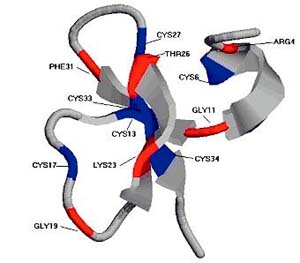| 2004 |

|
YEAR BOOK |
St Vincent's University Hospital, Dublin 4
|
The search for antimicrobial peptides
|
Antibiotic resistance is a major source of concern in medical and veterinary circles. Consequently the search for new drugs for targeting bacterial infection is a focus for many biomedical research groups, including the Innate Immunity Group at St Vincent's University Hospital. One possible alternative to traditional antibiotics is antimicrobial peptides (AMPs), part of the innate immunity and primary line of defence in organisms against invading pathogens. The peptides are short proteins, about 30-50 amino acids, that destroy a wide variety of microbes.

|

|
How to search for AMPs
Proteins, such as AMPs, are made up of sequences of amino acids. Sequences of nucleotides, the main building blocks of DNA in genes, ultimately determine which amino acids are made during protein synthesis. Knowing the sequence of DNA that codes for a protein in one animal, it is possible to use the information to search DNA sequences from another animal to identify the same or similar genes or proteins. In their search for AMPs, the group took a bioinformatics approach that makes use of data from databases of gene and protein sequences, computers and software.
To date, the group has identified eleven novel AMPs. Nine belong to the defensin family of AMPs, and one is from the cathelicidin family. The other is an AMP called LEAP (liver expressed anti-microbial peptide). The group has confirmed that these AMPs are expressed in a variety of chicken tissues.
Are these AMPs functionally important?
Proteins that have an important function in the immune response are continually evolving to combat newly emerging pathogens. Results of evolutionary analysis of one type of AMP in the chicken suggest that its innate immune response continues to adapt for host defence.
This project is commercially important because of the cost of bacterial infections to farming, including poultry farming, and the need to find an alternative to commonly used antibiotics that have become compromised in fighting bacterial infections. Ultimately these AMPs may be useful as anti-microbials in poultry farming or in novel functional food preparations. As such, they will be of interest to a wide variety of industries.
The Collaborators in this work are Dr Andrew Lloyd & Dr Tharappel James, TCD, and Dr Grace Mulcahy, UCD. It is funded by the Food Institutional Research Measure (FIRM) under the National Development Plan 2000�2006.
Contact: Professor Cliona O'Farrelly, Education and Research Centre, St Vincent's University Hospital, Dublin 4;
Tel: 01-209 4940; Fax: 01-283 8123; E-mail: [email protected]